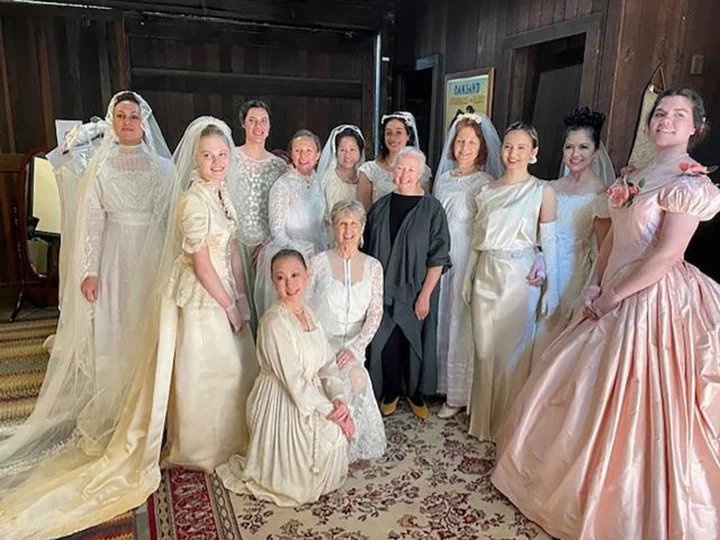On a spring day in Oakland, California, under the beams of a Victorian-age mansion, Karen Tierney stood surrounded by centuries of history. Tierney is a professional dressmaker and textile restorer, and had gathered 12 of her clients to model wedding dresses sewed or restored by Tierney's own hand. Some of the creations dated back to the 1800s, and others were handmade to evoke the age of Lord Byron and Jane Austen -- or whatever style and era a bride could dream of.
The April fashion show was held in the carriage house of an 1868 mansion that used to belong to California Gov. George Pardee, and served as a fundraiser for the property. It was also a celebration of tradition, family and more than 150 years of wedding dress history.
The threads of history
Tierney has been restoring wedding gowns and creating her own custom work for 18 years. Before that, she had a successful career as a graphic designer for Adobe, followed by several years of teaching graphic design at Stanford University. However, Tierney's career as a textile specialist began on the dance floor.
"While I was teaching, I had started doing vintage ballroom dancing," Tierney told CNN. "I got into a dance troupe where I had to have historically accurate costumes. People loved my costumes so much they asked me to start making some for them."
A lifelong seamstress, Tierney delved into the research and artistry of historic wedding gown and lace restoration. Such work isn't just highly specialized, it is sometimes so specific, it could be a science. Tierney says repairing lace requires fine, sharp needles and thread as thin as a spider's web.
"Then, there's everything that goes under a dress to make its shape. I once had to make type of crinoline (a stiff, cage-like undergarment worn under a skirt) called a 'elliptical' crinoline that required 40 yards of wire boning," she said. "It was quite a feat of engineering."
Interestingly enough, Tierney found the practicality of her graphic design skills -- the problem solving, a tendency toward perfection -- served her well in this new pursuit.
Reawakening the past
When it comes to emotionally charged fashion, wedding gowns likely take the cake. Tierney said she's been honored to work on dresses that have been donned by multiple generations of one family. One dress she restored was on its 11th wearer.
"Families love being involved in the process. They love to see it come alive. And I love the fact that these people care so much about these dresses, they are honoring their past. They're very, very sentimental about them. There is a lot of trust involved."
That may mean taking the entire thing apart and repairing it piece by piece, like Tierney did with one wedding gown dating back to 1894. Some clients request original, custom-designed historical pieces that Tierney calls fantasy gowns.
Whatever the project, it's something that takes a lot of time and care.
"Sometimes, when I receive a dress for restoration, I just put it on a dress form and look at it for a few days, deciding how to solve the problem."
Beauty on display
Historical wedding dress restoration is a highly specialized industry, and Tierney said she has deep, trusting relationships with many of her clients. So when Tierney was invited to show some of her creations for April's fundraising fashion show, she cast a net far and wide to bring some of her creations together.
"I contacted the brides and and everybody responded very positively," she said. "I got one gown from Maine, one from Montana, one from Oregon, and a couple from Southern California. They were sent in from all over the place."
All of the usual work came next; the fittings, the extreme measures to protect the precious gowns from wear and tear while hanging in the carriage house's designated "backstage."
"I thought there were going to be about 50 people. That's what the organizer said," Tierney said of the attendees. "But then there were 75. Then 100, 120, 150 people until the place was full."
One by one, the creations floated by: An 1865 top hand-crocheted in Ireland, fitted over a flowing, dove-gray backless gown. A confection of linen and lace that survived the devastating 1906 San Francisco earthquake. Pink taffeta adorned with fabric flowers, an original creation in the style of an 1868 reception dress. Among the models were a mother and her two daughters, wearing restorations and remakes showing off different eras: The bright white and lace cap sleeves of the 1960s, an ivory corset from 1883, and a draping, bias-cut silhouette from the 1930s.
Tierney says the people who lent their dresses to the show were thrilled to see them appreciated in a different light. And Tierney, who has spent a lifetime learning, creating and evolving, got to witness a new appreciation of her craft.
"I love making things," she said. "And more, I love making things beautiful again."

